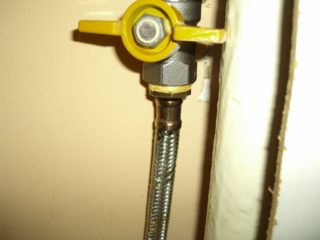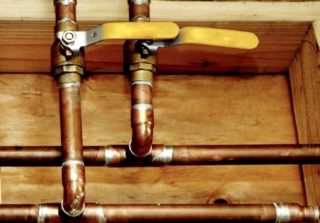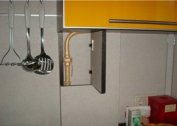Laying the trunk, transferring the gas pipe and installing the stove on its own is prohibited in the redistribution of housing. Without the permission of the special department, it is only permissible to move the stove to a limited extent. Gas workers with appropriate training are invited to replace the gas pipeline and relocate the communication sections.
Standards and rules for the placement of gas pipes in an apartment
The rules for the construction of a gas main in housing are prescribed in the text of SNiP 2.04.08 - 1987.
The principles of placing pipeline sections:
- the decoration on the walls of combustible materials is protected by plaster or metal panels;
- Do not remove the shut-off valve from the pipe, it is located in an accessible place;
- the gas pipeline is painted in a contrasting color with the wall with waterproof compounds;
- laying in the thickness of walls and horizontal ceilings is done using a case with a shock-absorbing insert.
Devices and installations are connected to the gas pipeline by rigid mounts. The conclusion about the possibility of altering the gas wiring is given by a technical specialist.
Reasons for the transfer of gas pipes
The official government program allows for major repairs and replacement of gas main risers in old apartment buildings for free.
Reasons for work:
- gas was detected when the valve was closed (repairs are done in the apartment);
- Visually distinguish damage to pipes and welds;
- Expired (for homes built more than 50 years ago).
Utility workers report a planned replacement of the supply pipeline, while the organization is developing a work schedule. Residents give access to equipment within designated periods.
Do not interfere with the repair, as Masters work with gas pipelines that are in common use and are on the balance sheet of a communal organization.
Redevelopment
A common reason for altering the gas distribution in the apartment is the purchase of a kitchen set, where there is a built-in heated panel or oven. For installation, you need to shorten or lengthen the pipe sections in order to bring gas to the installation site.
It is recommended that you contact a licensed design company to draw up a redevelopment plan, equipment movement and gas pipeline construction from a common input. In apartments it is forbidden to move risers, plates, pipelines to rooms. Coordination is also needed to combine the living room and kitchen.
Overhaul
Before starting the repair, the housing and communal services informs the residents of the inspection and the start of the repair. Carrying out dismantling and installation work causes discomfort for those living in the apartment. Residents worry that specialists might damage furniture or trim and try to enter into additional agreements with contractors.
The organization invited to remake the gas pipeline is not required to draw up an agreement with the owners of each apartment. Owners give access to the replacement site as part of a utility replacement program. Residents do not have the right to refuse, so as not to provoke further emergencies. In the absence of assistance, gas workers block a common riser valve.
Alteration of gas wiring
Sometimes a gas pipe passes through the hinged kitchen cabinets.The owners cut the back walls, make holes in the furniture, move the cabinet away from the wall with the help of gaskets-bars. Such actions entail a decrease in kitchen space. Specialists can digest the line at a different height from the floor, so that the installation of furniture takes place without obstacles.
The installation area of the sink may coincide with the installation site of the gas pipeline. Specifications (TU) do not allow laying a pipe with gas under the sink, so the gas pipeline rises above the cabinets, and a vertical section is made above the stove.
Preparatory stage
The flexible hose also cannot be changed independently. The extension, trimming and transfer of the gas pipe in the kitchen is carried out by the organization. The sequence and other features of the work must be known to the landlord in order to prevent illegal actions.
Usually 2 people work, who begin the reshuffle a week after the design of the project and obtaining approval. By the beginning of the work, there is already information about the areas that will be converted. There is a new arrangement of additional gas appliances, for example, a heating column.
General gas supply requirements
Pipes are installed only horizontally or vertically, rotation is allowed at 90 °. Diagonal laying, curved arc is not allowed.
Rules for the supply line:
- internal wiring is performed in an open way, decorative elements are made removable and with identification marking;
- it is forbidden to pass through ventilation risers, window and doorways;
- rigid elements are used, the length of flexible hoses for connecting plates cannot exceed 3 m;
- pipes are connected by welding, detachable contacts of two segments are prohibited.
Work begins with closing the valve on the house or a specific area. The service provider is responsible for interfering with the gas supply.
Getting permission
For illegal redevelopment or connection of plates, columns, a general administrative and criminal punishment follows, depending on the situation. The minimum fine is 2 thousand rubles, and if due to arbitrariness an accident occurs or people suffer, the perpetrator faces up to 5 years in prison.
The owner offers his own version of the pipe rearrangement, and the technicians of their communal service allow or not the indicated redevelopment. To call a specialist, the owner contacts the office at the place of registration. Sometimes additional firms are required, as reported by management employees.
Work order
If you connect an oven or stove, the owner purchases a bellows sleeve at his own expense. Masters bring metal pipes with them, because their value is already in the contract estimate. The kitchen is freed from unnecessary furniture and utensils to avoid hiccups in the work.
The owner has the right to demand the provision of gas organization certificates. Workers check qualification certificates and only after that they can begin re-equipment of the gas pipeline.
Tools and materials
Trimming and welding of gas pipeline sections is carried out using special devices, assemblies and tools that the craftsmen bring with them. Work is carried out in accordance with safety requirements.
For the gas main, the types of collectors are used:
- copper;
- steel;
- polypropylene.
Materials differ in durability and required properties, provide tightness and prevent leakage. Steel pipes are taken from the low-carbon variety St2, St4, withstanding excess pressure. For major re-equipment, shut-off valves made of gray cast iron, steel, bronze and brass are used.
Dismantling the old pipe
The line at the working area is blown after closing the common valve on the supply pipe to remove gas residues from the collector. When transferring, you need to cut a piece of the pipeline and weld a new segment in the desired direction. To remove an unnecessary segment, the master uses welding, a pipe cutter or a grinder. Previously, a metal file was used, but in modern conditions it is long and inefficient.
A plot is left on which stop valves are located at the entrance to the apartment. This section cannot be dismantled, the gas valve can be moved if the trunk in this place is badly damaged.
Change options
The area near the pipes should be open so that residents can learn about the leak in time and take action. It is forbidden to heat pipes into a wall and seal them tightly with plaster or other materials.
Put to fix the pipe:
- crimp clamps;
- hooks;
- mounting brackets;
- studs or pendants.
If there is an electrical wiring nearby, it is located no closer than 25 centimeters. The distribution panel is placed no closer than 0.5 meters from the gas pipeline. For the liquefied gas pipeline, a slope of 3 ° from the entrance is provided. If there is a counter, the slope is considered from this place.
Work process
Rubber hoses or rubber products are used less often, because bellows adapters are gaining popularity.
The actions are performed:
- The hole after cutting the site is welded.
- A hole is drilled in the pipeline at the point of attachment of the new segment using a power tool and a drill with a metal tip.
- A piece of pipe is attached by welding, at the end, if necessary, a crane is mounted.
When connecting the crane, tow or sealant is used, a sealing tape is used. After this, a flexible hose is connected to the gas device. Checks for gas leakage using soapy water.
Replacing the gas riser
During the procedure, there should be no strangers or smokers at the workplace. Before starting the replacement, the specialist will hang out a warning sign about the dangerous nature of the work. Simultaneous replacement of the riser and wiring in the apartment is not allowed, because a spark may cause an explosion.
The type of welding of the riser is selected depending on the thickness of the wall of the line. More often, steel elements with a diameter of 21.3 - 42.3 mm, with a wall thickness of 4 mm, which are connected by gas or electric welding, are used for feeding.
Features of the transfer in the kitchen
Gas pipes are arranged so that after installation there is the possibility of their repair, routine inspection or replacement. The insertion into the pipe is carried out so that during chemical analysis in the gas mixture the presence of oxygen is not more than 1%.
Gas must exit the pipeline evenly, without jerking, shocks, or popping. The check is carried out by purging the system, while making sure that in the process the gas does not enter the atmosphere of the room, ventilation shaft or chimney. Before the first launch, window openings are opened, and effective ventilation of the kitchen is provided.
Checking the entire system for leaks and performance
The test is done after the installation is completed, the tightness and performance are diagnosed. First, the general view of the system is examined, the connection, the tightening of the fittings, and the compliance with the design scheme are checked. Gas evolution is detected at the joints and nodes.
A soap solution is used to lubricate the joints of pipes with a hose, pairing a flexible eyeliner and a stove or oven. If bubbles form, the node requires refinement and re-diagnosis. The master draws up an act of work with a description of the features, the changes are recorded in the technical passport.
Coordination of gas pipe transfer operations
The owner contacts the gas service, clarifies the situation and receives advice. The application is made and submitted personally when visiting the organization’s office. Based on this document, the company sends a specialist to discuss the details.
A specialist examines the system, correlates the wishes of the client with the actual situation, answers questions.
Sometimes the customer’s plans are violated, because his wishes are contrary to safety precautions.
The organization draws up a budget for work and a plan for the conversion of the gas pipeline in the kitchen. The customer pays for the service, the company agrees to start work.












